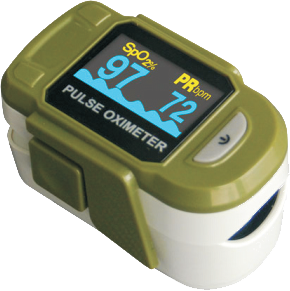
Fingertip Pulse Oximeter
Pulse oximeter is a very important and common device to check patient blood-oxygen saturation (SpO2) level and pulse rate.
Adult and Pediatrics
Measurement range
| SpO2 | |
|---|---|
| Measurement range | 70% - 99% |
| Resolution | 1% |
| Measurement accuracy | 80% - 99%: ±2% |
| 70% - 80%:±3% | |
| ≤69%: no definition | |
| Pulse Rate | |
| Measurement range | 30 - 235bpm |
| Resolution | 1bpm |
| Measurement accuracy | 30 - 99bpm: ±2bpm |
| 100 - 235bpm:±2% | |
| Display | |
| Type | Dual color OLED display |
| Parameters | SpO2, PR, Pulse bar, Plethysmogram |
| Mode | 6 display mode |
| Brightness | Adjustable 10 levels |
| Features: | |
| Small & lightweight design | |
| Dual color OLED display SpO2,PR,Pulse bar and Plethysmogram | |
| 6 display modes | |
| Low power consumption, automatically power off. | |
| Battery-low indicator. | |
| Adjustable brightness. | |
| Accommodates widest range of finger sizes from pediatric to adult. | |
| Alarm | |
| Alarm | Battery-low indicator |
| Mechanical | |
| Dimension | 58mm (L) * 32mm (W) * 34mm (H) |
| Weight | 50g (including batteries) |
| Battery | |
| Two AAA 1.5V, 600mAh alkaline batteries could be continuously operated as long as 30 hours. | |
| Environmental | |
| Operation Temperature | 5℃- 40℃ |
| Storage Temperature | -20℃- 55℃ |
| Operation Humidity | ≤80%, no condensation |
| Storage Humidity | ≤93%, no condensation |
| Measurement Performance in Low Perfusion Condition | |
| Required the test equipment (BIO-TEK INDEX Pulse Oximeter tester) the pulse wave is available without failure when the simulation pulse wave amplitude is at 0.6%. Interference Resistance Capacity against Ambient Light Device works normally when mixed noise produced by BIOTEK INDEX Pulse Oximeter tester. |
A pulse oximeter is a medical device that measures the oxygen level in your blood. It's usually used to check how well your lungs are working. The device consists of two sensors that are placed on different parts of your body, usually your finger. One sensor emits red light and the other detects it. The amount of light detected helps estimate the amount of oxygen in your blood.
If you have ever had an emergency, you know that every second counts. A pulse oximeter is a small, portable device that can measure your blood oxygen levels and heart rate. This information is critical in an emergency situation because it can help first responders and doctors make life-saving decisions. There are many different types of emergencies, but some of the most common include:
• Cardiac arrest
• Heart attack
• Stroke
• Anaphylaxis
• Asthma attack
• Chronic obstructive pulmonary disease (COPD) exacerbation
In each of these emergencies, time is of the essence. A pulse oximeter can provide vital information to first responders and doctors so that they can make the best possible decisions for treatment. This device can be the difference between life and death in an emergency situation.
If you or someone you know has asthma, COPD, heart disease, or any other condition that may affect their breathing, it's a good idea to keep a pulse oximeter in your first aid kit. Here's how to use it:
1. Place the sensor on the person's finger.
2. Press the power button to turn on the device.
3. The display will show the person's current blood oxygen level and pulse rate.
4. If the oxygen level is below 90% or the pulse rate is above 100 beats per minute, seek medical help immediately.
There are a few disadvantages of pulse oximeters that are worth mentioning. First, they can be expensive, so if you are on a budget, you may want to consider other options. Second, they require batteries, so if you are in an area with no power or your batteries die, you will not be able to use the device. Finally, pulse oximeters can give false readings if the person's skin is very dry or if they have nail polish on their fingers.
If you have a heart condition or are at risk for one, you should keep a pulse oximeter in your first aid kit. Here are some tips on how to use it correctly:
1. Check your pulse before using the oximeter. Place your index and middle finger on the side of your neck, just below your jawline. Use your other hand to check your watch and count the number of times your pulse beats in 15 seconds. Multiply this number by 4 to get your beats per minute (bpm).
2. Clip the sensor onto your finger. The sensor is usually a small, plastic clip that goes on the end of your finger.
3. Press the power button to turn on the oximeter.
4. Wait for the reading. The oximeter will usually take 5-10 seconds to give a reading.
5. Remove the sensor and power off the oximeter when finished.